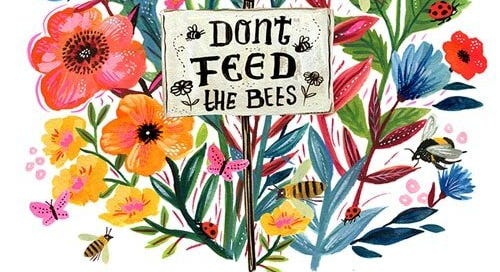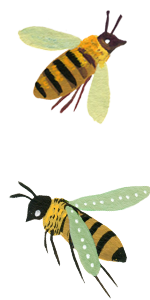WRITTEN BY MIRIAM BOS
Help!
Not to alarm you, but our insects haven’t been doing so well over the past few decades. Global long-term studies show dramatic declines in the insect population along with some of the insect-eating critters. Especially around the bees, there seems to be a buzz.
“How come?” you might think.
Well, bees and other pollinating insects (like butterflies, beetles, and wasps) play an essential role in our ecosystems. A third of all our food depends on pollination, and a world without pollinators would be really bad for our food production and, initially, for every one of us.
There are about 20,000 different bee species in the world. The most famous one is probably the honey bee. But, contrary to popular belief, it’s actually not the honey bee that’s endangered.
As humans domesticated this breed, nowadays, you could even consider looking at it as livestock.
However, it’s mostly the local species that are having more and more trouble.
A Bee’s life:
Bees live in colonies. Within these colonies, there are three types of bees; the queen bee, the worker bee, and the drones. The queen and worker bees are both females. The drones are male, and their only job is to mate with the queen.
As the queen bee is the only bee in the colony that can reproduce, her single job is to lay eggs.
The worker bees are the busiest bees of all and perform a lot of tasks. They clean the hive, take care of the offspring and most important of all; they also collect the pollen and nectar from the flowers to feed the colony.
That’s quite a buzzzy existence, isn’t it? Poor things!
Disappearing:
Many debates are going on about the reasons why bees are disappearing.Research points out that there seem to be multiple causes.One of the biggest culprits is probably the use of insecticide on our crops.Other reasons are: the pollution of rivers + water sources, the pollution of the soil (which leads to contaminated plants), the changing climate, the reduction of wild prairies and also, believe it or not, the extension of lawns in people's gardens.
It may seem like a drop in the ocean, but I really believe that every little bit can help.
So I’ve searched the internet and composed a top 10 to help save the bees (and other pollinators).
1) Don’t use pesticides of any sort on the plants in your garden unless they are non-toxic plant-derived products.The toxic used in most pesticides will contaminate your plants and chances are high that the bees will ultimately get ill and die.
You can make sure that the plants you buy for your garden are not pre-treated with these pesticides.
Fortunately, there are some friendlier options to get rid of your weeds and insects.
Google for other alternatives, or click here for a quick one.
A guide to bee-friendly pesticides
2) If possible, plant a mixture of (native) trees and shrubs that are an excellent resource for both pollen and nectar.
If you don’t have enough space in your garden, then planting local bee-friendly flowers will be a great alternative. Diversity is good for the bees, so a mixture of different kinds would give them the optimal results. The flowers will be a great resource for pollen and nectar, and the butterflies will thank you too!
Use a search engine to find out what flowers are best to plant in your region.
To help you on your way, I found this handy blog post that contains a list of trees and flowers that bees like.
Want Bees? Plant these.
3) By the way, you can also sponsor bee sanctuaries in your city.
4) Avoid planting lawns or large pebbled zones in your garden. These type of gardens are like a desert to the bees and some of the other insects.
Instead of a typical grass carpet, you could opt for a bee-lawn.
A bee lawn is a combination of cool-season grasses and low-growing flowering plants that produce nectar and pollen for both the bees and the butterflies.
5) If you can stand it, then consider not to remove all the weeds and let some of them blossom.
Garden weeds are very important to the lifecycle of the bee, and in the long run, also to our biosphere. Take for example the flowers of the dandelion. They are great resources for bees and other insects. And on top of that, they are a cheery bunch too. It’s a pity that they have such a bad reputation for being hard to remove.
If you like, you can read this great article about the importance of weeds.
Why weeds are important to the lifecycle of the bee.
6) DON’T help the bees with sugar water and especially DON’T GIVE THEM HONEY water.
Honey can become contaminated, which can lead to infections within a beehive. If one bee becomes ill, the disease can spread and potentially kill an entire colony.
In recent years, it has become a popular concept to help a tired bee by offering it a bit of sugar water on a spoon. Some people even place bowls with sugar water in their gardens so the bees can make a quick pit-stop before going on their way.
It might feel like a good deed (and unfortunately, I’ve done it once or twice in the past myself), but in the long run, you’re not really helping them.
On Facebook, a fake post purportedly written by Sir David Attenborough went viral. It encouraged people to help out a tired bee with a mixture of sugar and water. But as mentioned, it was fake news, and the BBC confirmed that Mr. Attenborough didn’t spread it.
A lot of beekeepers (these are the people who know what they are talking about) were not very happy with this well-meant trend, as it could cause harm to the bees in the long run.
Many of the beekeepers are trying to emphasize that it’s not a good idea to feed the bees. However, it would help to plant pesticide-free flowers, trees, and bushes instead.
In case you’re not convinced, please read these articles from (interviewed) beekeepers.
Don’t feed sugar water to exhausted bees
Bee sugar water is fake news
Please don’t feed my bees
However, some professional beekeepers do feed their bees, but only under specific circumstances. And again, these are professionals. They understand bees and know how to care for them properly. Here is an article that explains when and how it’s done.
Feeding-honey-bees-to-prevent-starvation
7) Honeybee water source.
Add a water source to your garden for the bees.
Honeybees need to stay hydrated while they work hard to pollinate your garden.
Adding a waterer to your garden will help them a lot.
This could be a fun project to work on with your children.
Fill a bowl or bucket with water and cover the surface with wine corks. The corks will float and provide the bees with a place to land.
You can make it as pretty as you like.
Another alternative is using a pretty water-filled dish, birdbath or tray that you fill with gravel, rocks, shells, sea glass, moss, twigs or whatever you like. As long as there is still water in it, and there is something the bee can land on so it can drink, you’re good to go.
Building the best water source for my bees.
8) Build (or buy) a bee hotel from untreated wood for your bees.But be aware that these may take a lot of your time if you want to do it right.
Bee or insect hotels are trending, and there are many garden centers that sell them nowadays. However, a lot of these commercially produced goods don’t meet the requirements for the bee-, or insect hotels. Mostly, they just look fancy, and many of them don’t come with a clear guide on maintenance, which is important to ensure the survival of the insects.
For example:
They shouldn’t be too large.
They need an overhanging roof to keep nesting bees dry and out of the wind.
They should be free of splinters.
The backsides of the holes need to be closed.
They need to be checked regularly for pests and diseases.
The cocoons need to be harvested, cleaned and stored before Winter.
Early spring, it’s time to put them out again.
Here is a great article on how to take good care of the bees.
Bee hotels: Taking care of the cocoons
And on Youtube, you can find various videos on how to clean the cocoons.
I found this article that tells a bit more about beehouses and how to make your own. Of course, you can also Google for it yourself.
Do bee hotels really work?
9) Buy local organic and raw honey from your local beekeepers to support their businesses.
In comparison to large commercial companies who often focus on their sales, local beekeepers are passionately committed to their bees and will do their best to take care of their health and wellbeing.
Also, researches claim that eating raw honey has interesting health benefits as well. This honey is unprocessed and contains (among other things) vitamins, antioxidants and could even reduce your allergies for local pollen.
5 Reasons to get a taste for local honey
10) Consider planting medical kit for bees.
Organic beekeepers use environmentally friendly ways to keep off mites and pests within the beehives. Luckily for the bees, different anti-microbial and anti-fungal herbs may help prevent diseases within the hives caused by these intruders.
In this article, you can find a list of herbs with descriptions why they benefit both your health and that of your local pollinators.
Among them, you will find Thyme, Apple Mint, Oregano, Echinacea, Borage, Bee balm, Lemon balm, Elderberry, Chamomile, and more.
I hope you enjoyed this blog post.
If you have any comments or tips and tricks, let me know and leave a message below.
List of resources:
Want Bees? Plant these.
Consider planting a Bee Lawn
Bee types and Life Cycles
Build a Bee-friendly garden
Plant medicinal herbs for the bees
Don’t feed sugar water to exhausted bees
Bee sugar water is fake news
Please don’t feed my bees
5 Reasons to get a taste for local honey
Building the best water source for my bees.
Bee hotels: Taking care of the cocoons
Do bee hotels really work?
About Bee hotels
Why weeds are important to the lifecycle of the bee.









